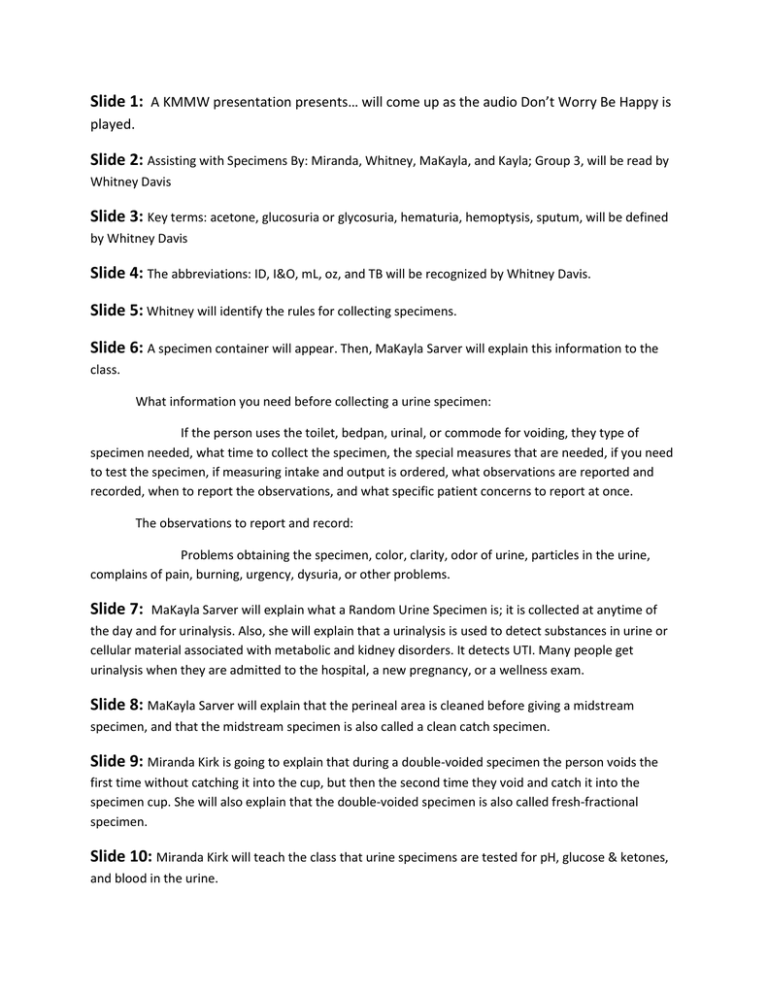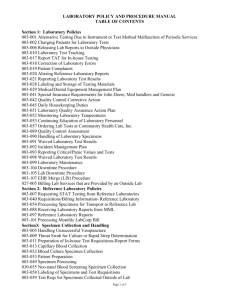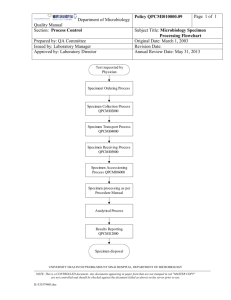Rough Draft
advertisement

Slide 1: A KMMW presentation presents… will come up as the audio Don’t Worry Be Happy is played. Slide 2: Assisting with Specimens By: Miranda, Whitney, MaKayla, and Kayla; Group 3, will be read by Whitney Davis Slide 3: Key terms: acetone, glucosuria or glycosuria, hematuria, hemoptysis, sputum, will be defined by Whitney Davis Slide 4: The abbreviations: ID, I&O, mL, oz, and TB will be recognized by Whitney Davis. Slide 5: Whitney will identify the rules for collecting specimens. Slide 6: A specimen container will appear. Then, MaKayla Sarver will explain this information to the class. What information you need before collecting a urine specimen: If the person uses the toilet, bedpan, urinal, or commode for voiding, they type of specimen needed, what time to collect the specimen, the special measures that are needed, if you need to test the specimen, if measuring intake and output is ordered, what observations are reported and recorded, when to report the observations, and what specific patient concerns to report at once. The observations to report and record: Problems obtaining the specimen, color, clarity, odor of urine, particles in the urine, complains of pain, burning, urgency, dysuria, or other problems. Slide 7: MaKayla Sarver will explain what a Random Urine Specimen is; it is collected at anytime of the day and for urinalysis. Also, she will explain that a urinalysis is used to detect substances in urine or cellular material associated with metabolic and kidney disorders. It detects UTI. Many people get urinalysis when they are admitted to the hospital, a new pregnancy, or a wellness exam. Slide 8: MaKayla Sarver will explain that the perineal area is cleaned before giving a midstream specimen, and that the midstream specimen is also called a clean catch specimen. Slide 9: Miranda Kirk is going to explain that during a double-voided specimen the person voids the first time without catching it into the cup, but then the second time they void and catch it into the specimen cup. She will also explain that the double-voided specimen is also called fresh-fractional specimen. Slide 10: Miranda Kirk will teach the class that urine specimens are tested for pH, glucose & ketones, and blood in the urine. pH change can be caused from illness, food, and drugs glucose & ketones may appear in urine from the rapid breakdown of fat for energy blood in the urine can be caused by injury and disease. She will also explain how to use Reagent Strips, After the patient leaves the urine specimen, dip the strip into the urine, take out and compare to the colors on the container of unused reagent strips. Slide 11: A specimen pan will appear and Miranda will cover stool specimens, she will explain that stool specimens are checked for blood when internal blood is suspected; the stool cannot be contaminated with urine. Stools are studied for fat, microbes, worms, and other abnormal contents. Slide 12: Kayla Murray will introduce sputum specimens. She will be defining what sputum is: mucus from the respiratory system. She will tell that sputum is studied for blood, microbes, and abnormal cells and it is often hard and painful to do. Slide 13: Last, but definitely not least Kayla will give tips on how to promote pride. You must always identify the person correctly, let them know who you are, do things to eliminate embarrassment, and let them collect their own specimen if at all possible. Slide 14: As the Golden Girls Theme Song plays, Let’s see what you learned will appear as well as the link to the review game. Kayla will say, Now let’s review. Rough Draft created by: Whitney Davis







